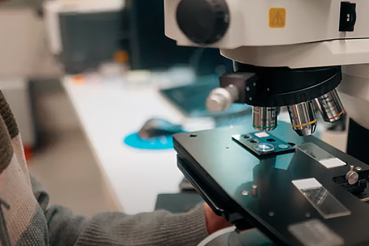For decades, plastics have played an integral role in the success of joint replacements, allowing them to work better and last longer than ever before. But artificial joints break down over time, leaving microplastics in our bodies.
With philanthropic support, Rush researchers are illuminating the effects of microplastics on the body and learning how to mitigate them.
“We’ve gotten to a point in hip and knee replacements where we have a very reliable, long-lasting and life-transforming procedure,” said Joshua Jacobs, MD, the Grainger Director, Rush Arthritis and Orthopedics Institute, and Chairman Emeritus of the Department of Orthopedic Surgery at Rush. “While joint replacement procedures are highly successful, we need to go further to address the problem of microplastic debris generated from polyethylene prosthetic components.”
A partnership between Rush and the Alliance for the Great Lakes — a nonpartisan nonprofit that examines plastic pollution of its namesake lakes, which provide drinking water for more than 40 million people — is designed to enhance what we know about microplastics from both medical and environmental perspectives.
Understanding microplastics’ impact on the body
Through the Robbins and Jacobs Family Biocompatibility and Implant Pathology Lab, Rush researchers have been collecting implants — more than 10,000 over more than four decades — through a program that involves retrieval of failed implants from revision surgery and successful implants postmortem. Tremendous insights have come out of the lab, contributing to the evolution of the plastics used in joint replacements to increase device longevity and improve safety for patients, according to Dr. Jacobs, who has been affiliated with Rush since 1980 and has researched particles from implants since he was a medical student.
“Our laboratory’s purpose is to understand why some implants fail,” Dr. Jacobs said. “If we understand why they fail, we can devise strategies to improve their performance. Through our postmortem retrieval program, we also learn why some implants are successful for decades. This knowledge allows us to design implants that function better and last longer.”
One common way implants fail is through a local foreign body response to nano- and micro-particles. “We’ve found particles can travel throughout the body,” Dr. Jacobs said.
“We’ve seen both metal and plastic particles in the lymph nodes, the liver, the heart and bone marrow.”
Particles can even reach the brain — with unknown consequences. To learn more about any impact of particles on brain function, the Implant Pathology Lab is collaborating with researchers at the Rush Alzheimer’s Disease Center.
The researchers are also examining potential systemic effects of these particles. However, finding plastics on nano- and micro-levels in the human body presents challenges, including differentiating their sources. Researchers currently use a novel infrared spectroscopy method to identify the carbon-based particles in the tissue that cause reactions. But there is a need for improved technology and tissue retrieval banks to push the envelope in studying microplastics, according to Robin Pourzal, PhD, director of implant materials analysis for the Department of Orthopedic Surgery at Rush.
“There are solutions to all of these problems, but they’re unfortunately costly, take time, take research and take the will to actually look,” he said. “We won’t find any microplastics if we don’t look. So that’s what we’re doing. We can’t ignore this issue.”
Forming an alliance
As Rush researchers advance the study of microplastics on our bodies, the Alliance for the Great Lakes focuses on microplastics in the environment. Joel Brammeier, president and CEO of the Alliance for the Great Lakes, said roughly 22 million pounds of plastics — whether from waste, manufacturing or other sources — are making their way into the Great Lakes every year.
“Unfortunately, the plastic we see showing up in the environment is eventually finding its way into our water,” Brammeier said. “It never really goes away. It just gets smaller and smaller. Once something finds its way into our water, it is going to find its way into all of us.”
The unique partnership with Rush helps the Alliance connect its environmental work with what’s happening inside the human body. The Alliance invests in further research, seeks transparency from manufacturers, creates responsibility for products at the end of their life and pushes for more sustainable, less-toxic objects. They align with Rush researchers’ focus on improving health and developing better devices for orthopedics.
“It was cool to see the work that’s happening at Rush, especially to be able to go from an implant that was inside somebody to the point where you can see how the particles coming off are moving through the human body,” he said. “Plastic pollution connects with people in a way other things don’t, because you can see it. It's visceral.”
Andrea Densham, senior policy advisor to the Alliance, added that the science being done at Rush is informing ongoing research into human health exposure to microplastics, which enter the body through not only artificial joints but also plastic pollution in the environment.
“It is in these partnerships between researchers, public policy experts, business innovators and our supporters that we can identify new and impactful solutions that will improve human health for decades to come,” Densham said.

Promoting philanthropic partnerships
A recent event titled “Microplastics Under the Microscope” was hosted by the Rush Bone and Joint Advisory Council and driven by member Theresann Seeger, who has been a crucial philanthropic partner to orthopedics. Seeger saw similarities in work being done by Rush and the Alliance to examine what it means to have plastics in our bodies — whether they come from the environment or orthopedic implants.
“This work is important because, as a society, we are losing focus on the damage overuse of single-use and plastic products in general are causing in our environment as well as our health,” she said. “Becoming more conscious is a first step toward changing our habits.”
Brian Cole, MD, MDA, acting chair of the Department of Orthopedic Surgery at Rush and managing partner of Midwest Orthopaedics at Rush, said the partnerships between Rush, the Alliance for the Great Lakes and generous philanthropic supporters are vital to accelerating this work.
“We wouldn’t be here without Theresann Seeger,” Dr. Cole said. “We’re very appreciative of everything she and her husband, Dave, have done on behalf of the Department of Orthopedics. Finding synergies helps create unique opportunities. When it comes to research, we are always considering: What will have an impact on our health and well-being? The reciprocity that comes from this relationship will have an enormous impact on our mutual mission.”




